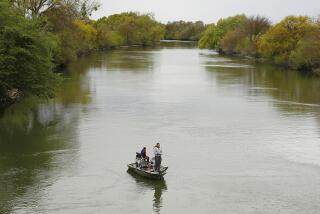Company Passes the Salt to Racing Enthusiasts
- Share via
SALT LAKE CITY — It’s springtime, and the Bonneville Salt Flats, where race car drivers have been breaking speed records for generations, are under water, a shallow pool mirroring the mountains beyond.
But in a few weeks, winter’s rainwater will evaporate, leaving a blazing white stretch of salt that curves off into the distance like a shoreline with no ocean.
This year, the salt will probably be a little bit thicker than last.
About half an inch thicker, in fact--a total of 1.9 million tons of salt spread across 28,000 acres, according to the federal Bureau of Land Management, which recently reported the preliminary results of a 2-year-old salt restoration project.
The results are good news for racing enthusiasts worried that the Bonneville Salt Flats are deteriorating, the salt stripped away by mining and erosion.
“It’s real exciting,” said Rick Vesco, a race driver who helped found Save the Salt, the group that pushed for the salt restoration. “It was getting so that there wasn’t going to be any more salt flats.”
Save the Salt began in 1989, when the drivers who gather on the flats each summer noticed the salt was so thin that the sticky mud underneath was slowing down their cars. The seven-mile loop used to be nearly twice as long, and parts of the track had some 18 inches of salt in the 1940s.
Vesco said it’s now less than a half-inch in spots.
For decades, the gleaming moonscape on the Utah-Nevada state line has also been mined for potash fertilizer.
Reilly Industries, which bought the Bonneville potash plant from Kaiser Chemical in 1988, forces water through canals crisscrossing the flats into evaporation ponds, from which the potash is removed. But the process also strips an estimated 850,000 tons of salt from the flats each year, leaving it in the ponds in heaps up to 4 feet high.
Now Reilly is reversing the process and pumping brine back out onto the flats--as much as 7,000 gallons per minute. The company, which is spending $1 million in initial expenses and $80,000 a year to maintain the pumps, estimates that when the water evaporates, it should leave half an inch of new salt per year.
Save the Salt negotiated a deal under which Reilly puts up the money and BLM monitors the results. Most of the land is government property.
“It’s a good scenario where the government and industry is working with recreational interests and it’s a win-win situation for everyone,” Vesco said.
Amateur hot rodders still flock to Bonneville. But lately, top racers have migrated to Nevada’s Black Rock Desert, where they say the dry riverbed has more speed.
Save the Salt hopes the salt restoration will reestablish Bonneville’s claim as the nation’s fastest test track. The group also wants to make sure the flats stay white and gleaming.
“They’re a nearly unique geological phenomenon,” said BLM spokesman Don Banks.
More to Read
Sign up for Essential California
The most important California stories and recommendations in your inbox every morning.
You may occasionally receive promotional content from the Los Angeles Times.













